![]() May-June 2001
May-June 2001
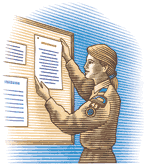
Edited by Scott Daniels
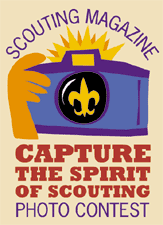
Send entries for 'Capture the Spirit of Scouting' photo contest
What is the spirit of Scouting? Is it the excitement of a Cub Scout pinewood derby? The thrill of a Venturing wilderness trek? Or a proud mom's face as she pins the Eagle Scout Award onto her son's uniform?
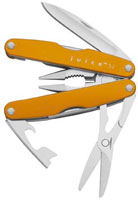
Show us your ideas by entering Scouting magazine's "Capture the Spirit of Scouting" photo contest.
The contest theme applies to all BSA programs: Cub Scouting, Boy Scouting, Varsity Scouting, and Venturing.
Entries must be received by Oct. 1, 2001. Winners receive BSA Supply Division gift certificates and have their photographs published in Scouting's March-April 2002 issue and on the magazine's Web site.
RULES FOR ENTERING
- Open to all registered BSA members (adult and youth). Deadline for entering is Oct. 1, 2001.
- Only unmounted color prints will be accepted, to a maximum size of 8 by 10 inches. Mounted prints or transparencies (slides), or other media, will not be accepted. No more than three entries per person.
- All photographs must have the following information taped on the back: name, address, daytime and evening phone numbers, unit number (if applicable), and council name.
- For the purpose of the contest, all prints submitted become the property of Scouting magazine. Winners must certify that photographs are their own original work.
- No photographs will be returned. The BSA, Scouting magazine, and its agents are not responsible for loss of photographs. The decisions of the judges are final.
- Mail entries to Scouting Magazine Photo Contest, S304, P.O. Box 152079, Irving, TX 75015-2079.
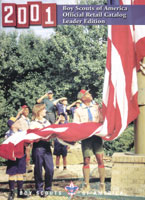
Winners will receive BSA Supply Division gift certificates as follows: Grand Prize—$400; 1st Place—$300; 2nd Place—$200; 3rd Place—$100; Honorable Mention—$25. In addition, all winners will receive a Juice S2 compact multipurpose tool, courtesy of Leatherman Tool Group Inc.
National jamboree welcomes visitors

For one week this summer thousands of daily visitors will join more than 40,000 participants at the 2001 National Scout Jamboree at Fort A.P. Hill, Va.
For an enjoyable visit, Scout units and families planning a day at the jamboree should note the following information:
- The national Scout jamboree will be open to visitors July 25 to Aug. 1, from 9 a.m. to 5 p.m. (to 11 p.m. on arena show days).
- All visiting Scout units or groups must have the required insurance as shown on tour permits and apply for either a local or national tour permit.
- Adult leadership must accompany youth at all times during a jamboree visit.
- Program areas and activities are restricted to jamboree participants only. However, some program events, such as arena shows, may be visited by guests.
- Visiting units must limit their stay at the jamboree to one day.
Boys' Life short story wins coveted reading award
The short story "The Orange Armband," by Gary Wisler, published in the December 2000 issue of Boys' Life, has won the Paul A. Witty Award from the International Reading Association.

The coveted award is given to the author of an original short story published in a periodical for children. This marks the third year in a row and the fourth time since 1986 that a short story from Boys' Life, the BSA magazine for young readers, has won the Witty award.
The International Reading Association promotes high levels of literacy for all by improving the quality of reading instruction through studying the reading process and teaching techniques; serving as a clearinghouse for the dissemination of reading research through conferences, journals, and other publications; and actively encouraging the lifetime reading habit.
A family tree of Eagles
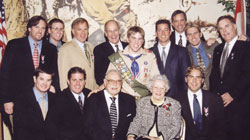 A court of honor gathering of Rogers family Eagles includes (front row) John, Matt, Tom and Virginia, and Judd Rogers, and (back row) Andy, Brian, Gary, BSA National Commissioner Rick Cronk, new Eagle Scout Tyler, Nevada Area Council Scout Executive Jeff Hunt, and Don, Ben, and Jim Rogers. (Photograph courtesy of the Rogers family) |
In January, Tyler Rogers, 15, became the 10th Eagle Scout in two generations of the Rogers family.
"Being an Eagle is one of the greatest honors I have ever achieved," Tyler told more than 100 friends, family, and fellow Scouts at his court of honor. "Now I have to live up to what this award means."
The Rogers family Eagle Scout tradition began with Tyler's grandparents, Tom and Virginia Rogers. Tyler's two uncles started Scouting with Virginia as their den mother.
In 1956, Gary Rogers, now chairman and CEO of Dreyer's Grand Ice Cream in Oakland, Calif., became the family's first Eagle Scout. He was followed by brother Don, in 1961, and Tyler's father, Jim, in 1965.
Today, Don is a general physician in Olympia, Wash., while Jim serves as CEO of Kampgrounds of America Inc.
Gary's four sons, Andy, Matt, Brian, and John, as well as Tyler's brothers, Ben and Judd, are Eagle Scouts.
At Tyler's court of honor, Rick Cronk, BSA national commissioner, praised the Rogers family for its outstanding commitment to Scouting and presented each of the family's Eagle Scouts with a letter of congratulations from Chief Scout Executive Roy L. Williams.
Cronk cited as especially noteworthy the fact that every eligible Rogers male in the last two generations has become an Eagle Scout—an achievement attained by only 2 percent of all Scouts.
Leave No Trace training courses available

Leave No Trace, a national education program that promotes and teaches responsible outdoor recreation, offers a schedule of Master Educator courses through October 2001. The five- and six-day courses are presented by the National Outdoor Leadership School (NOLS) and the Appalachian Mountain Club in partnership with Leave No Trace Inc., the U.S. Forest Service, National Park Service, Bureau of Land Management, U.S. Fish and Wildlife Service, corporate sponsors, individuals, and organizations involved in outdoor education and recreation.
The LNT Master Educator courses focus on minimum-impact camping and travel, wildland ethics, and effective methods for teaching low-impact skills to others.
Each course focuses on a specific ecosystem or recreational activity, such as hiking, horsepacking, canoeing, and sea kayaking. Graduates are qualified to teach Trainer courses and become local resources on LNT strategies and techniques.
For information on the remaining 2001 courses, see the LNT Web site, http://www.lnt.org or contact Susan Benepe, NOLS, 288 Main Street, Lander, WY 82520, (307) 335-2292, outreach@nols.edu, or Dara Houdek, Appalachian Mountain Club, P.O. Box 298, Gorham, NH 03581, (603) 466-2721, dhoudek@amcinfo.org.
Guidelines help volunteers organize effective disaster-relief efforts
When hurricanes, floods, earthquakes, and other disasters occur in the United States or elsewhere, Scouts and others look for ways to help.
To ensure that disaster victims receive aid in a timely and effective manner, the Federal Emergency Management Agency (FEMA) and the National Voluntary Organizations Active in Disaster (NVOAD) developed guidelines for effective support of relief efforts.
Financial contributions to voluntary disaster-relief agencies are often the best kind of donation, but Scout units should always consult their local council office before any formal involvement in this area. According to BSA Rules and Regulations, units can participate in drives "for the relief of humanity" only "by giving personal service" that does not "involve the use of BSA youth members as collectors or solicitors of money."
"Basically, this means members of the BSA cannot raise money for other organizations, which includes door-to-door solicitation," says Richard Schmidt, associate director of the BSA's Finance Support Division. "Of course, individuals and families may participate in such fund-raising activities, but not as members of the BSA."
Some other key guidelines:
- Confirm the need before beginning a collection of goods. Used
clothing is rarely a useful item to collect for disaster relief, and
be wary of claims that "everything is needed."
Rushing out and gathering what they think the victims and responders need "is often more of a hindrance to relief efforts than a benefit," says Craig A. Nemitz, disaster response coordinator for America's Second Harvest, the largest nongovernmental hunger relief organization in the United States. - Donate through an experienced disaster-relief organization. This ensures that the right items will reach those in need. Disaster-relief organizations and government agencies often have toll-free numbers to call for information.
- Plan transportation of goods in advance. Do not assume unsolicited relief supplies will be transported at no charge or at government expense.
- Donated goods must be well packed and labeled. After confirming a need and a plan to receive, store, and distribute them, be sure the goods are properly sorted, packaged, and labeled.
- Get advance training and experience. Affiliating with a voluntary agency involved in disaster response and recovery is a good way to accomplish this. See the NVOAD Web site, http://www.nvoad.org, for a list of organizations involved in disaster preparedness, prevention, response, and recovery in the United States. To learn about organizations involved in disaster relief elsewhere, see http://www.interaction.org.
Affiliating with a local agency like a food bank also enables a Scout unit to serve the needy all year long, says Craig Nemitz. "A troop's involvement can have a positive impact on many organizations," he notes.
Affiliation with a food bank also insures a Scout unit of effective involvement during emergencies.
"Our network food banks are tasked to respond to disasters in their assigned area," Nemitz says. "Scouts can be a vital source of support at those times, especially if an ongoing relationship has already been developed. And Scouts become better spokesmen to help educate the public about how to properly respond to a disaster."
A list of 190 food banks in the America's Second Harvest network is available at http://www.secondharvest.org.
'Roving' camp takes Scouting to 1,800 kids
More than 1,800 inner-city youth and children of migrant farmworkers had a chance to experience some of the fun and values of Scouting last summer—nearly all of them for the first time—thanks to a "Roving Scout Camp" sponsored by Michigan's Gerald R. Ford Council.
Between mid-June and mid-August, the roving camp brought its "Values on Wheels" program to more than 50 neighborhood sites in Grand Rapids and the surrounding area. Two teams of three council staff members and four college students (employed part time by the council) traveled in two council-owned vans. Their camp program delivered four to five hours of games, sports, and educational activities, using the format of a typical Cub Scout meeting.
"The educational aspect is built around the Learning for Life package, as well as materials from The Boy Scout Handbook and the Wolf, Bear, and Webelos Scout books," said council program director Tom Mills.
The camp was established three years ago in cooperation with the West Michigan Migrant Farm Association and the parks and recreation departments of five area cities—Grand Rapids, Holland, Muskegon, Muskegon Heights, and Grand Haven.
"Basically, we followed the outline of a den meeting, with a standard opening, closing, and activity period," said Mills, "and we structured our program and lesson plans to fit the needs and schedules of the day camps the kids were attending.
"In some cases, we held a one-hour session each day for five straight days," he said. "In others, the sessions were an hour one day a week for five weeks; and in one instance, we did the whole thing in a single four-hour stint."
The educational part of the program has three main thrusts, Mills said: teaching respect for cultural and racial differences, stressing citizenship responsibilities, and emphasizing the importance of honesty and truthfulness.
In 1998, the roving camp's first year, it served about 400 children, Mills said, while this summer, attendance is expected to be more than 2,000.
The camp's staff includes a professional teacher and several members who speak fluent Spanish. "Most of the migrant workers' children are Hispanic, and some speak very little English," Mills said.
"When the fruit-picking season is over in Michigan, the migrants go back to Texas or Florida, but we try to give them an introduction to Scouting that they can take with them," he said.
"Many of these children know nothing about Scouting. This is a way to acquaint them with it, and they are very receptive.
"All campers are given BSA pencils along with a letter for their parents, thanking them for letting their kids attend and offering further information on Scouting and how to join," Mills said.
For the inner-city children who live in the area year round, the council makes a concerted effort to follow up on the roving camp's success and keep resident youngsters interested in Scouting.
"The council," Mills said, "is working to develop additional materials that will serve as a door-opener to Scouting for those kids who are permanent residents. We don't have any hard-and-fast numbers on how many actually join a troop or pack, but we definitely feel we're helping to spread the message of Scouting in places where it may not have been heard before."
As a new feature of the 2001 program, the council is trying to arrange transportation to allow a one-day trip for all roving campers to a regular BSA camp, where they can experience some of the most appealing parts of Scouting firsthand.
"Most of these kids have never been in a wilderness setting," said Mills. "We think it will be a really memorable experience for them."
—Bill Sloan
Cub Scout Pack presents crime-prevention program for its members and the public
While surfing TV channels, den leader Sharon Walker, Pack 9, Carthage, Mo., saw a child holding on to her bike in order to prevent a stranger from forcing her into his car.
Walker was watching a demonstration by Escape School, a nationwide community service project that shows children how to recognize dangerous situations and get away from potential abductors.
Because the program fit in with the advice in How to Protect Your Children From Child Abuse: A Parent's Guide, the booklet included in Cub Scout handbooks, Walker went to the Web site, http://www.escapeschool.com, for information on its availability. "I thought it would be neat to have the pack host a similar Escape School seminar here in Carthage, to offer it to the whole community," she said.
The pack committee agreed. They scheduled the program during the pack's annual crime prevention month in August, combining it with a child-identification fingerprinting program that the police department provided.
Walker booked the high school gym for the event. She used a publicity kit provided by Escape School to write press releases, put up posters, and distribute literature to day-care centers and churches. Bob Kalkofen, an Escape School instructor and the Scoutmaster of Troop 91, Shawnee Mission, Kan., taught the seminar.
The event drew families with children of all ages. The Cub Scouts conducted the opening ceremony, and then Walker welcomed everyone, saying, "Let's learn some stuff to keep our kids safe."
As part of the program, Cub Scouts and other children helped Kalkofen demonstrate defense techniques. To get away from a person who drove up beside him, a boy showed how to run in the opposite direction. A girl looked for a "good adult" at the first sign of trouble, holding on to his arm and saying forcefully, "I need help now!" A boy broke an adult's hold on his wrist by "windmilling," rapidly swinging his arm in a circle.
Committee member Sydney Merritt noted that the seminar reinforced the advice in BSA materials. Knowing this kind of information "makes a difference in how kids handle themselves, and it involves very simple, common sense techniques," she said.
Because of Sharon Walker's inspiration and planning, the event was a success for the pack and the community. "I'll be pushing to do this again next year," she said.
—Suzanne Wilson
Tiger Cubs program changes strengthen ties to Cub Scouting

Effective June 1, 2001, the new position of Tiger Cub den leader will replace the position of Tiger Cub coach in Cub Scout pack leadership. The change is part of a continued effort to remove barriers that prevent Tiger Cubs from participating fully in Cub Scouting.
Tiger Cub den leader will be a required position in a Cub Scout pack when Tiger Cub youth are registered. However, the new position will not replace the concept of shared leadership among families in a Tiger Cub den. The Tiger Cub den leader, who will attend pack committee meetings, will also coordinate the shared leadership among den families.
Also being eliminated, along with the position of Tiger Cub coach, is the designation of Tiger Cub den coordinator. The responsibilities of that position will become part of the den leader's role.
Monthly Tiger Cub meeting plans will now be included with the activities and den meetings for Wolf and Bear dens in the annual publication Cub Scout Program Helps 2001-2002 (BSA Supply No. 34304D). Monthly program helps segments are also bound into copies of Scouting magazine that go to Cubmasters and assistants, den leaders and assistants, pack trainers, and commissioners.
Additional information on the new leadership position and other Tiger Cubs program restructuring will be made available in May at the BSA national annual meeting in Boston, Mass.
Service project opportunities available at national park sites
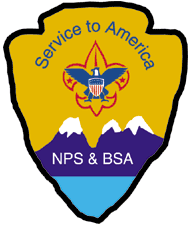
As a result of the joint National Park Service (NPS) and BSA Service to America project, more than 8,000 Scouts completed approximately 50,000 hours of volunteer service at National Park Service sites across the country to date.
The program is open to Cub Scouts, Boy Scouts, and Venturers. To participate, Scout leaders log on to http://www.servicetoamerica.org to find the name, phone number, and e-mail address of a park's volunteer coordinator, plus a listing of available projects. The leader can then contact the coordinator to arrange a volunteer project.
Upon completion of 12 hours of service, a Scout qualifies for the NPS and BSA Service to America patch, which is available from Eastern National, a nonprofit educational association that supports the Park Service and maintains the database and Web site.
The Web site is updated monthly and includes information about the program, available project opportunities, stories from Scouts about their experiences, and patch order forms. Information is also available from Carol Snyder at (215) 283-6900, ext. 164, carols@easternnational.org.
Program resources by the day, week, and month

May Shoulders back, head up straight. In dozens of activities ranging from carrying a backpack to sitting at a computer to brushing your teeth, it's important to watch your posture, says the American Chiropractic Association, which sponsors Correct Posture Month every May. To learn how to be kind to your back, see TT>http://www.amerchiro.org or call (800) 986-4636.
May 6-12 Polish those apples. This week is Teacher Appreciation Week—the perfect time to thank your teachers for their dedication to you, and a great opportunity to be extra-cooperative in class.
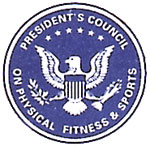
May Get moving. Run, dance, or jump rope to celebrate National Physical Fitness and Sports Month. Since 1983, the President's Council on Physical Fitness and Sports has promoted physical activity, which leads to healthier, more productive lives. For ideas on celebrating the month, call the President's Council on Physical Fitness and Sports at (202) 690-9000 or see http://www.fitness.gov.
June 2 Hike, bike, or run on a trail. "Saving the Trails: In Your Community" is the theme of the ninth annual National Trails Day, sponsored by the American Hiking Society. More than 3,000 trail organizations, agencies, and businesses across the country host various events such as new trail dedications, bike rides, trail maintenance projects, and backcountry trail hikes. For more information, visit http://www.americanhiking.org or call (301) 565-6704.
—Melanie Radzicki McManus
Creative district camporees turn a weekend into great Scouting memories
District camporees are as much a part of autumn and spring as falling leaves and April showers. Most have memorable moments, but some do even more, with unique themes and features, to ensure that Scouts never forget the weekend experience. A few examples:
IN THE DARK
If you think advancement skill competition is difficult in daylight, try it after dark. That's what more than 300 campers did during the Night Hike Fall Camporee held by the Tussahaw District of Georgia's Flint River Council ast September.
Ten competitive events—including rope rescue, cooking relay, first aid, and log rolling—started at 8 on Saturday evening and lasted until 4 in the morning. "We told the kids to get plenty of rest the day before, because they were going to need it," said district program chairman Bob Bloomer.
In a tent-pitching patrol competition, all members except the patrol leader were blindfolded and not allowed to speak. For an edible plant contest, patrols were shown 25 clearly labeled plants—with 10 of them identified as poisonous. The labels were then removed, and Scouts had to pick the 15 safe edibles from the group.
"It was kind of like 'Survivor' on TV," Bloomer said. "Each time you picked a poisonous plant, somebody in your patrol 'died.' The patrol with the most survivors was the winner."
All events were based on Tenderfoot, Second Class, and First Class requirements and were held on a 138-acre tract a few miles from the council office. Because of a strict fire ban in the area, there wasn't even a campfire to shed light on the activities.
"Flashlights and compasses were essential equipment for getting from one event to another," Bloomer said. "The kids had a great time, but when taps finally sounded at 5, they were more than ready to hit the sack."
CONFEDERATES AND YANKEES
For 400 Scouts and adult leaders, the Milwaukee County Council's Civil War 2000 Fall Camporee was a journey back in time.
Some 24 troops from the council's Southeast and West districts camped at the historic Old Wade House in central Wisconsin with 1,400 uniformed Civil War reenactors, several hundred horses, and several dozen cannons.
The reenactors stage an annual simulated battle in honor of Wisconsin brigades that fought in the Civil War.
Before the fighting, a reenactor dressed as President Abraham Lincoln gave an inspiring campfire speech to the Union troops; another, dressed as Confederate Gen. P. G. T. Beauregard, exhorted the gray-clad ranks on the other side.
"It was a terrific experience for the boys," said Dan Lentz, Boy Scout training chairman for the Southeast District. "They learned how it felt to live in an 1860s military camp during a hard-fought campaign."
Adult leaders also felt the sensation of time travel. "As I walked toward the woods, I passed a lady in a hoop dress," reported camporee chairman Jay Kempinger.
"'Don't go down there, Sir,' she said, 'the Yankees are coming; there'll be fightin' soon.' As I entered the woods, I heard the sound of musket fire in the distance. At that moment, I knew a part of my mind would always remain back in time, in the years of the Civil War."
The camporee also provided 100 Scouts with an opportunity to pass requirements for the Cinematography and American Heritage merit badges.
—Bill Sloan
May-June 2001 Table of Contents
Copyright © 2001 by the Boy Scouts of America. All rights thereunder reserved; anything appearing in Scouting magazine or on its Web site may not be reprinted either wholly or in part without written permission. Because of freedom given authors, opinions may not reflect official concurrence.
| The Boy Scouts of America | http://www.scouting.org |